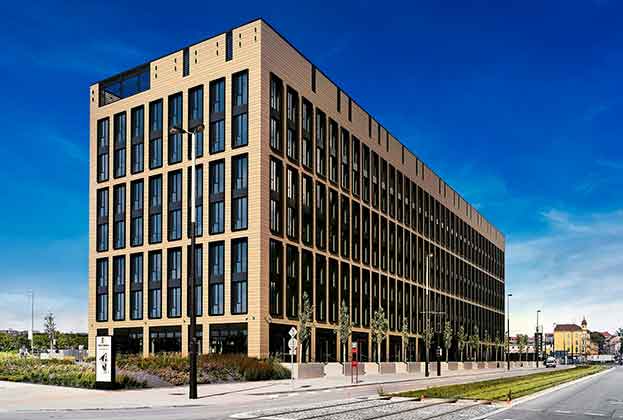Record low vacancy rates could hamper take up levels in 2020
Berlin has been the largest single contributor to Europe’s office take-up during 2019 and is forecast to reach 1,050,000 sq m by end year 2019, up 15% on 2018’s volume. Munich is forecast to see 850,000 sq m of take-up by the end year, though this is down on the 982,000 sq m recorded last year. Both cities are now undersupplied with vacancy rates at 1.3% and 2.2% respectively.
Although German cities have been relatively late to the ‘coworking’ revolution, flexible offices rose from 4.2% of total take-up in 2018 to 5.7% for Q1-Q3 2019, with 146,000 sq m of space taken by flex operators during the first three quarters of 2019. Berlin has already seen a 124% increase in take-up on the levels recorded in 2018, accounting for 9.8% of total take-up in the German capital. WeWork also took 21,589 sq m in Frankfurt and Design Offices signed for 16,300 sq m in Munich.
Berlin has been the largest single contributor to Europe’s office take-up during 2019 and is forecast to reach 1,050,000 sq m by end year 2019, up 15% on 2018’s volume
Savills Research
London West End and London City both recorded the strongest growth in prime rental levels across Europe, largely due to a lower base of rents recorded in 2018. This generally reflected hesitancy in occupier decision-making post-EU referendum which carried into 2019. Vacancy rates now stand at 4.0% and 5.7% respectively in the West End and City markets. Several flexible office companies are now adjusting strategies to target corporate deals in excess of 50 desks at a time, including Facebook and HSBC. Into 2020, prime rents are expected to remain flat in the City and rise 1% in the West End, as vacancies marginally increase reflecting deliveries of new stock.
Paris CBD office take-up reached 323,000 sq m during Q1-3 of 2019, in line with the same level last year, and a total of 415,000 sq m is forecast for the full year. Flexible office space has been one of the major contributions to office demand in Paris so far this year and has accounted for 23% of total take-up so far this year, up from 15% in 2018. Last year, WeWork was already a leading protagonist in the major deal segment in the capital, with no fewer than five leases signed for an average unit size of nearly 10,000 sq m.
Paris CBD’s prime office rents have risen by 0.8% to €845 per sq m over the past 12 months, and are forecast to reach €850 per sq m by end 2020. Average CBD rents have, however, risen 5.6% over the same period and non-CBD rents are up 10.9% as occupiers are being forced to look for alternatives. CBD vacancy rates have now been squeezed to only 1.3% of total stock, the joint lowest in Europe which will hamper demand into 2020, forecast to be in the region of 400,000 sq m.
Gross take-up in Budapest in the third quarter of 2019 reached 191,235 sq m, representing a 41% growth compared to the same period of last year (111,430 sq m). The largest new deal was concluded in South Buda submarket; due to continued expansion, Thyssenkrupp’s development centre is moving to the South Buda Business Park occupying 16,000 sq m office space. The office vacancy rate has decreased to a record low of 5.9%, representing a 0.4 PPS reduction QOQ on the Budapest office market.
Rents have remained stable over the past 12 months at €222 per sq m in Bucharest, as vacancy has dipped under 8% as at Q3 2019. Take-up of 262,000 sq m during Q1–3 2019 represents a 9.3% increase on the equivalent level last year. Flexible offices accounted for 6% of the total take-up so far this year, down from 8% last year. By end year, 400,000 sq m of space is forecast to be taken, 12% above the level last year and the strongest level since the pre-global financial crisis (GFC).
Prime Warsaw office rents have risen by 2.1% over the past 12 months to €288 per sq m, reflecting vacancy rates falling from 10% to 8.2% over this period. 142,000 sq m of office space has completed in the Polish capital so far this year, and an additional 823,000 sq of space is forecast to complete by end 2021, reflecting 15% of total office stock. Leasing markets remain in rude health, with 689,000 sq m of space signed for this year, up 10% from the same level last year, as Warsaw remains in line to reach 820,000 sq m of gross take-up by end year.
Prague’s vacancy rate remains close to 5% at the end of Q3 2019, down from over 16% just four years ago, following among the strongest economic growth in Europe. There is 333,100 sq m of office space currently under construction across Prague but only 56% of that space is still available. Gross take-up has reached 298,000 sq m during Q1–3 2019, 16% down on the same period last year as flexible office leasing has accounted for 4% of activity so far during 2019, down from 6% last year. End year take-up is expected to reach 400,000 sq m during 2019 and up to 365,000 sq m during 2020. Prime rents have increased 1% over the past 12 months, and are expected to grow a further 3.2% to €294 per sq m by 2020.
Milan’s office vacancy rate continues around the 11% mark, though this has been on a downward trajectory for the past few years. Flexible offices has been a growth market as WeWork open their next unit in Milan and some smaller coworking operators have taken space in void retail space on the high street, though this is still only a small part of the market. There still remains upward pressure on Milan rents, however, which have risen 9% to €600 per sq m over the past 12 months. Similarly, secondary rents have risen 6% in this period. Going forward, we expect further growth in CBD rents and stability elsewhere as some new office projects come to the fore and older stock is modernised.
Amsterdam’s vacancy rate dropped from 5.7% to 5.5% over the course of the year. A shortage of available high-quality space in the city centre has meant that only 14,679 sq m of net take-up was leased in the third quarter of 2019. Prime CBD rents have risen 9.8% since end 2018 and average rents have risen 21% during this time. Flexible office take-up remains at around 9–10% across the Netherlands as providers expand out of a constrained Amsterdam CBD – for example, The Office Operators (TOO) signed for space in Almere during Q1 2019. We forecast flexible office demand to accelerate in the coming years and total demand to reach 25% of take-up in the next 10 years.
Luxembourg’s prime rents have remained stable at €564 per sq m so far in 2019, though with vacancy rate falling from 4.5% to 3.2%, this will add upward pressure on rents. In 2020, we expect prime rents to rise 6.4% to €600 per sq m. A shortage of space has left occupiers with fewer options but to renew their current leases – take-up is expected to reach 200,000 sq m in 2019, around 15% down on 2018’s level. In 2020, 82% of the 140,179 sq m development pipeline is already pre-let as tenants may find that they have little choice but to renew their leases.
Stockholm’s prime office rents have risen 7.6% over the past 12 months to €728 per sq m as vacancy rate hovers around 3%. Secondary rents have likewise risen 10% over the past 12 months as demand remains limited in the city centre. 116,000 sq m of new stock next year will help to release some built up occupier demand and we expect take-up levels to remain fairly stable with 2019. In Oslo, Q1–3 2019 gross take-up reached 512,000 sq m, 12% above the same period last year, which puts the Norwegian capital in a healthy position for 700,000 sq m of take-up forecast for the full year. CBD rents rose 5.6% over the last 12 months to €575 per sq m, despite a slight increase in vacancy rate from 5.3% to 5.6%. Scandinavian domestic economies continue to outperform the rest of Europe, though the Norwegian krone has lost nearly 6% of its value against the Euro over the past six months despite four interest rate rises since last year.
Stockholm’s prime office rents have risen 7.6% over the past 12 months to €728 per sq m as vacancy rate hovers around 3%
Savills Research
Madrid’s 515,000 sq m of take-up in Q1-3 2019 is 13% above the same level last year, though the volume of available space in the Madrid office market continues to decrease. Nearly 1.17m sq m was vacant at the end of September, leaving the vacancy rate of the total market at 8.6%. Between 2020 and 2021, almost 390,000 sq m is expected to be incorporated into the market, of which 75,000 sq m is already committed (20% of the total). This will continue to grow over the next few months, as it is usual for agreements to be signed when the project is close to completion.
Barcelona’s 328,000 sq m of take-up up to Q3 2019 represents a 6.4% increase on the same period in 2018. The vacancy rate has fallen to only 4.5%, and rents have risen 10% YoY to €330 per sq m. Over the next 20 months (2020 and 2021), almost 255,000 sq m is expected to come onto the market, mainly from new developments (217,000 sq m, 85% of the total). However, refurbishments are still present in the market (seven assets totalling 37,000 sq m). 10% of the new space planned until 2021 is already committed to pre-let contracts. Due to the general lack of supply, this figure will increase over time, likely reaching a level similar to that recorded in the last two years, with just over 90% of occupancy in new projects.
Coworking has remained a big theme in Spain this year, 17% of year-to-date (YTD) take-up in Barcelona has been from flexible office operators, against 9% in Madrid. In the last quarter, WeWork signed almost 4,000 sq m distributed over two deals. Wojo, a French company specialising in flexible office space, set up business in Barcelona, where they will occupy 8,000 sq m of a newly-developed office building in 22@.
In Lisbon, office take-up is forecast to reach 200,000 sq m for the full year, in line with 2018’s level. The vacancy rate hovers around 5% as office stock has been converted to residential apartments along Avenida da Liberdade, which could threaten to hamper city centre take-up volumes in 2020. Due to the lack of supply available, the response to the demand for larger spaces has been more difficult, being currently more concentrated in the area of the Western Corridor, which is the area with the highest availability of around 11.5%. Over the next three years, we will see new projects coming in, especially concentrated in the Parque das Nações (Expo) zone, which is by definition the zone of choice for new technology and communication companies. Flexible office activity has only accounted for 3% of total letting activity for the first three quarters of 2019, down from 8% for 2018.
Dublin’s year-to-date total take-up in the office market reached 194,727 sq m. The vacancy rate rose from 8.3% to 8.5% in Q3. Benchmark rents are €700 per sq m although most CBD lettings are transacting at headline rent levels a bit below this. Typical lease lengths are 10 years with six months rent-free. Reflecting the changing nature of Ireland’s economy, the ICT sector has been a major driver of Dublin office employment and take-up in recent years, with technology firms accounting for 55.4% of take-up in 2018, and 39.1% year to date. Despite this Dublin’s office market is characterised by its diverse occupier base. Financial services firms, real estate companies (including serviced office providers), and the public sector have experienced steady jobs growth and continue to account for significant take-up.
Read the articles within European Offices Outlook below.
.jpg)




